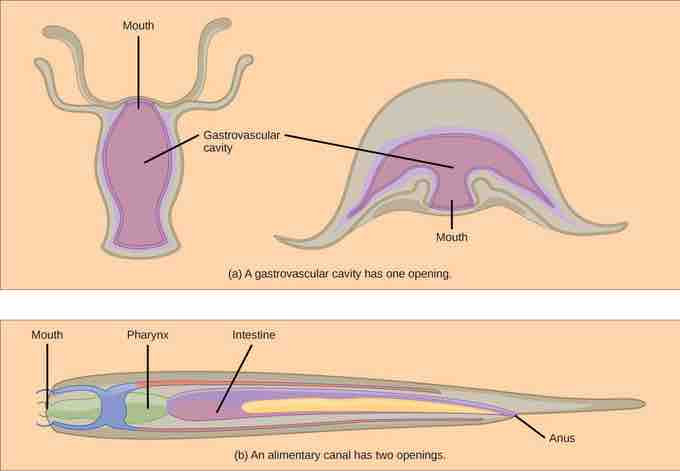Invertebrate Digestive Systems
Animals have evolved different types of digestive systems break down the different types of food they consume. Invertebrates can be classified as those that use intracellular digestion and those with extracellular digestion.
Intracellular Digestion
The simplest example of digestion intracellular digestion, which takes place in a gastrovascular cavity with only one opening. Most animals with soft bodies use this type of digestion, including Platyhelminthes (flatworms), Ctenophora (comb jellies), and Cnidaria (coral, jelly fish, and sea anemones). The gastrovascular cavities of these organisms contain one open which serves as both a "mouth" and an "anus" .

Invertebrate digestive systems
(a) A gastrovascular cavity has a single opening through which food is ingested and waste is excreted, as shown in this hydra and in this jellyfish medusa. (b) An alimentary canal has two openings: a mouth for ingesting food and an anus for eliminating waste, as shown in this nematode.
Ingested material enters the mouth and passes through a hollow, tubular cavity. The food particles are engulfed by the cells lining the gastrovascular cavity and the molecular are broken down within the cytoplasm of the cells (intracellular).
Extracellular Digestion
The alimentary canal is a more advanced digestive system than a gastrovascular cavity and carries out extracellular digestion. Most other invertebrates like segmented worms (earthworms), arthropods (grasshoppers), and arachnids (spiders) have alimentary canals . The alimentary canal is compartmentalized for different digestive functions and consists of one tube with a mouth at one end and an anus at the other .
Invertebrates with Extracellular Digestion
Invertebrates like grasshoppers have alimentary canals with specialized compartments for digestion. Their food is broken down in their digestive tract (extracellular digestion), rather than inside their individual cells (intracellular digestion).
Once the food is ingested through the mouth, it passes through the esophagus and is stored in an organ called the crop; then it passes into the gizzard where it is churned and digested. From the gizzard, the food passes through the intestine and nutrients are absorbed. Because the food has been broken down exterior to the cells, this type of digestion is called extracellular digestion. The material that the organism cannot digest is eliminated as feces, called castings, through the anus.
Most invertebrates use some form of extracellular digestion to break down their food. Flatworms and cnidarians, however, can use both types of digestion to break down their food.